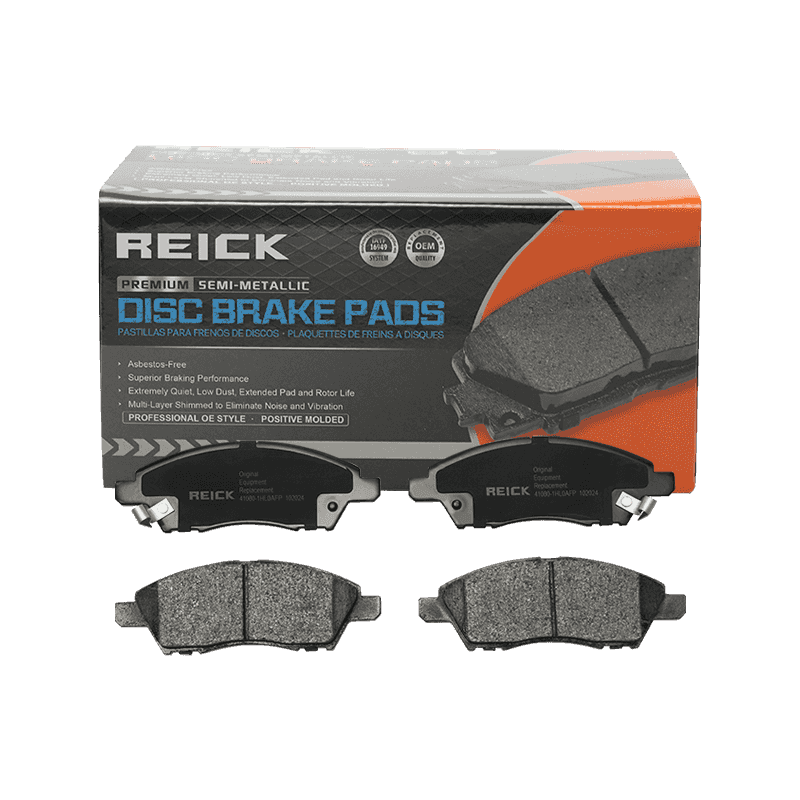 2025.11.14
2025.11.14
 Industry News
Industry News
When it comes to choosing brake pads for a vehicle, understanding the differences between the available types is critical. Among the most common options are semi-metallic brake pads and low-metallic brake pads. Both have their advantages and limitations, and selecting the right one depends on factors like driving style, vehicle type, environmental conditions, and performance requirements.
Semi-metallic brake pads are composed of a combination of metals, including steel, copper, and iron, mixed with friction modifiers and fillers. Typically, metals make up 30–65% of the pad’s material. This composition gives semi-metallic brake pads their defining characteristics:
These pads are commonly found on trucks, SUVs, and performance vehicles, where robust braking capability is necessary. However, the trade-off comes in terms of rotor wear and noise. Semi-metallic brake pads are harder on rotors, so frequent inspection and maintenance are recommended.
Low-metallic brake pads contain a smaller percentage of metal, typically around 10–30%, combined with organic materials such as carbon, rubber, and resins. The metal is primarily used to improve heat transfer and braking performance. Key characteristics include:
Low-metallic pads are often used in passenger vehicles where comfort and quiet operation are prioritized, though they still offer reliable stopping power under normal driving conditions.
When comparing semi-metallic and low-metallic brake pads, several factors stand out.
The most significant difference lies in the metal content. Semi-metallic brake pads have higher metal content (30–65%), while low-metallic pads contain less (10–30%). This difference affects heat dissipation, durability, and braking force. Higher metal content in semi-metallic pads improves performance under heavy loads but increases rotor wear.
Semi-metallic brake pads generally provide superior braking performance, especially in high-speed or high-temperature conditions. The metal content allows for consistent friction levels, reducing the likelihood of brake fade. Low-metallic pads perform well under normal conditions but may experience reduced performance during prolonged heavy braking or in extreme heat.
Semi-metallic brake pads tend to produce more noise than low-metallic pads due to the metal-to-metal contact with the rotor. In contrast, low-metallic pads are quieter, offering a smoother and more comfortable driving experience. This difference can be particularly noticeable in city driving or during light braking.
Higher metal content in semi-metallic brake pads means they generate more brake dust and can be harsher on rotors. Low-metallic pads, with their lower metal content, create less dust and are gentler on rotors, potentially reducing maintenance costs over time.
Semi-metallic brake pads are generally more durable than low-metallic pads. They withstand high heat better and are suitable for heavy-duty applications, including towing and aggressive driving. Low-metallic pads may wear faster under heavy braking but last adequately under regular driving conditions.
Both semi-metallic and low-metallic brake pads are generally affordable, though prices can vary depending on the manufacturer and vehicle compatibility. Semi-metallic pads may offer better value for drivers who require high performance and durability, while low-metallic pads provide a quieter and smoother ride for everyday use.

| Feature | Semi-Metallic Brake Pads | Low-Metallic Brake Pads |
| Metal Content | 30–65% | 10–30% |
| Heat Resistance | Excellent | Moderate |
| Braking Performance | High | Moderate |
| Noise | Higher | Lower |
| Brake Dust | More | Less |
| Rotor Wear | Higher | Lower |
| Durability | High | Moderate |
| Ideal Use | Heavy-duty, performance vehicles | Passenger vehicles, everyday driving |
Selecting between semi-metallic and low-metallic brake pads depends on your driving habits, vehicle type, and priorities:
In some cases, vehicle manufacturers recommend specific brake pad types to match the vehicle’s braking system. Always consult your owner’s manual or a professional mechanic before making a final decision.
Regardless of the brake pad type, proper maintenance ensures safety and longevity:
Both semi-metallic and low-metallic brake pads have their place in modern vehicles. Semi-metallic pads excel in durability, high-temperature performance, and consistent braking under heavy loads, making them suitable for performance vehicles, trucks, and SUVs. Low-metallic pads offer quieter operation, reduced rotor wear, and satisfactory braking for daily driving, making them ideal for passenger cars and moderate driving conditions.
Understanding the differences between these two types of brake pads helps drivers make an informed choice, balancing performance, comfort, and maintenance considerations. By selecting the right type of pad and maintaining them properly, drivers can ensure safe, reliable, and efficient braking for years to come.